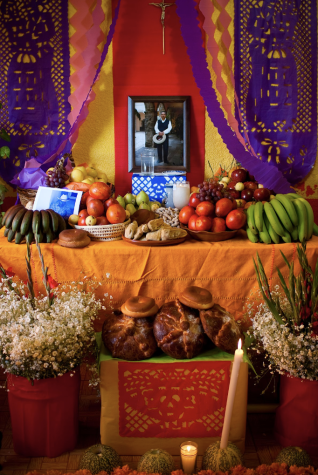Dias de Los Muertos: How different South American Cultures Celebrate the Day of the Dead
This is an ofrenda, which is often used to commemorate the lives of the deceased. The altar is decorated with delicacies that the deceased loved, flowers that represent the Earth they once walked on, candles that represent the element of fire, and colorful draperies to assist the deceased on their journey back to the Earth.
December 16, 2022
In order to discuss, how different cultures celebrate Días de Los Muertos or Day of the Dead, we must first talk about the history of the cultural holiday. Días de Los Muertos is a Latin American holiday where deceased family members are celebrated and are welcomed back for a reunion that includes delicious foods, drinks, and a wonderful celebration. The holiday is celebrated from October 31-November 2. A famous symbol that represents Días de Los Muertos is the Marigold Flowers. These flowers represent the Day of the Dead because these flowers were first introduced to Nahua Tribe, an indigenous group local to Mexico, by Tonatiuh, the sun God, so that they could honor the dead. The origins of Day of the Dead originated 3,000 years ago during pre-Columbian Mesoamerica. The Aztecs and other Nahua tribal members lived in central Mexico. Their philosophy on death is that this event is a significant and ubiquitous part of human life.

So how is Días de Los Muertos celebrated? On the cultural celebration, it is believed that the boundary between the spirit and the real world dissolves, allowing decreased family members to reunite with their families on Earth. In Mexico where it originated, there are parades that are held with individuals in costumes, food offerings for the dead, and lots of dancing. In Colombia, Días de Los Muertos, also known as Día de Los Difuntos is celebrated on the first of November when family members go to cemeteries to respect their deceased loved ones by paying respect. They do this by decorating their Ofrendas with marigold flowers, foods and objects they once loved, and water. Individuals who celebrate these holiday use elements of earth, water, fire, and air to adorn their families’ Ofrendas. In Ecuador, Días de Los Muertos, also known as Día de Los Difuntos, is celebrated on the 2nd of November. Similar to Colombians, Ecuadorians bring traditional food such as the colada morada which is a purple corn drink, and guaguas de pan which is a sweet bread in the form of a baby. In El Salvador, Días de Los Muertos is celebrated as the Calabiuza Festival on the first of November. In the town of Tonacatepeque, a festival with held where locals dress in costumes and celebrate the native folklore of the holiday. A famous traditional dish that is served later in the festival is cooked pumpkin and honey for the individuals celebrating.

In Los Angeles, there is a large Latinx community present. Therefore, in places such as Hollywood Forever Cemetery or Olvera Street, there are festivals and parades held in honor of the dead. On Olvera Street, there is a plaza in which people can set up Ofrendas for offerings to the souls of the deceased and in celebration, live entertainment is held during the holiday. The holiday being celebrate is important to the Latinx community because remembering where one came from is important to one’s individual identity. And Días de Los Muertos is an important holiday that is celebrated in the Latinx community. This also serves as an opportunity for allies to learn about the diverse community present in Los Angeles. People can learn how to respect other people’s holidays as well as celebrate the lives of their own deceased loved family members.

Works Cited
Gonzalez, Damaly. “7 Dia De Los Muertos Celebrations across Latin America.” HipLatina, 2 Sept. 2020, https://hiplatina.com/dia-de-los-muertos-celebrations-latin-america-caribbean/.
History.com Editors. “Day of the Dead (Día De Los Muertos).” History.com, A&E Television Networks, 30 Oct. 2018, https://www.history.com/topics/halloween/day-of-the-dead.



